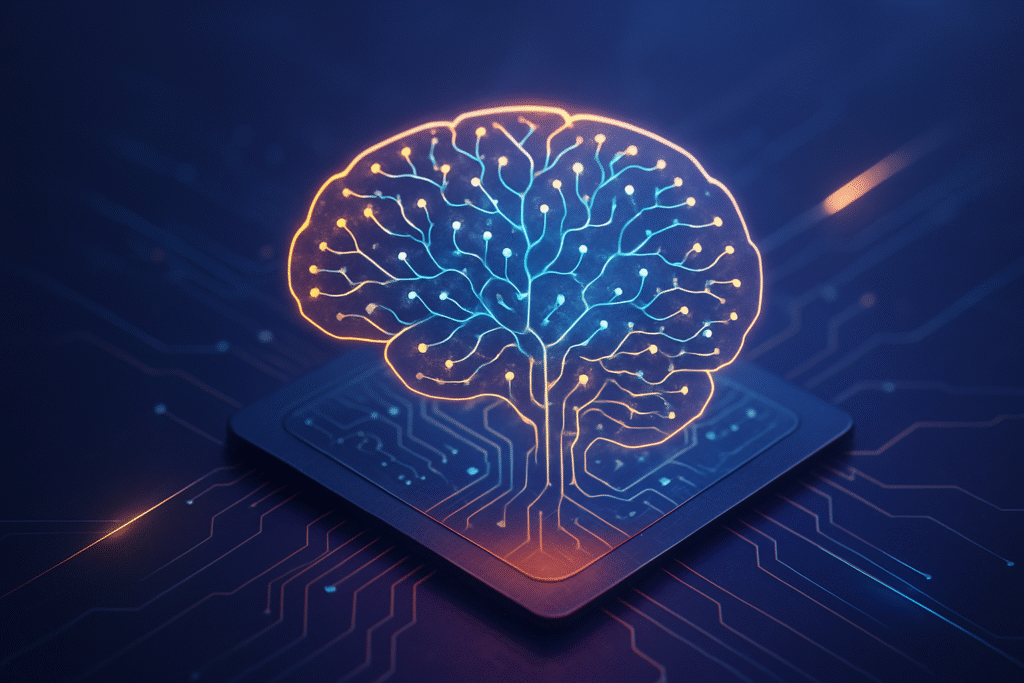
October 15, 2025 – The landscape of artificial intelligence is undergoing a profound transformation as neuromorphic computing and brain-inspired AI chips move from theoretical promise to tangible reality. This paradigm shift, driven by an insatiable demand for energy-efficient, real-time AI solutions, particularly at the edge, is set to redefine the capabilities and sustainability of intelligent systems. With the global market for neuromorphic computing projected to reach approximately USD 8.36 billion by year-end, these advancements are not just incremental improvements but fundamental re-imaginings of how AI processes information.
These groundbreaking chips are designed to mimic the human brain's unparalleled efficiency and parallel processing capabilities, directly addressing the limitations of traditional Von Neumann architectures that struggle with the "memory wall" – the bottleneck between processing and memory units. By integrating memory and computation, and adopting event-driven communication, neuromorphic systems promise to deliver unprecedented energy efficiency and real-time intelligence, paving the way for a new generation of AI applications that are faster, smarter, and significantly more sustainable.
Unpacking the Brain-Inspired Revolution: Architectures and Technical Breakthroughs
The core of neuromorphic computing lies in specialized hardware that leverages spiking neural networks (SNNs) and event-driven processing, fundamentally departing from the continuous, synchronous operations of conventional digital systems. Unlike traditional AI, which often relies on power-hungry GPUs, neuromorphic chips process information in a sparse, asynchronous manner, similar to biological neurons firing only when necessary. This inherent efficiency leads to substantial reductions in energy consumption and latency.
Recent breakthroughs highlight diverse approaches to emulating brain functions. Researchers from the Korea Advanced Institute of Science and Technology (KAIST) have developed a frequency switching neuristor device that mimics neural plasticity by autonomously adjusting signal frequencies, achieving comparable performance to conventional neural networks with 27.7% less energy consumption in simulations. Furthermore, KAIST has innovated a self-learning memristor that more effectively replicates brain synapses, enabling more energy-efficient local AI computing. Complementing this, the University of Massachusetts Amherst has created an artificial neuron using protein nanowires, capable of closely mirroring biological electrical functions and potentially interfacing with living cells, opening doors for bio-hybrid AI systems.
Perhaps one of the most radical departures comes from Cornell University engineers, who, in October 2025, unveiled a "microwave brain" chip. This revolutionary microchip computes with microwaves instead of traditional digital circuits, functioning as a neural network that uses interconnected electromagnetic modes within tunable tunable waveguides. Operating in the analog microwave range, it processes data streams in the tens of gigahertz while consuming under 200 milliwatts of power, making it exceptionally suited for high-speed tasks like radio signal decoding and radar tracking. These advancements collectively underscore a concerted effort to move beyond silicon's traditional limits, exploring novel materials, analog computation, and integrated memory-processing paradigms to unlock true brain-like efficiency.
Corporate Race to the Neuromorphic Frontier: Impact on AI Giants and Startups
The race to dominate the neuromorphic computing space is intensifying, with established tech giants and innovative startups vying for market leadership. Intel Corporation (NASDAQ: INTC) remains a pivotal player, continuing to advance its Loihi line of chips (with Loihi 2 updated in 2024) and the more recent Hala Point, positioning itself to capture a significant share of the future AI hardware market, especially for edge computing applications demanding extreme energy efficiency. Similarly, IBM Corporation (NYSE: IBM) has been a long-standing innovator in the field with its TrueNorth and NorthPole chips, demonstrating significant strides in computational speed and power reduction.
However, the field is also being energized by agile startups. BrainChip Holdings Ltd. (ASX: BRN), with its Akida chip, specializes in low-power, real-time AI processing. In July 2025, the company unveiled the Akida Pulsar, a mass-market neuromorphic microcontroller specifically designed for edge sensor applications, boasting 500 times lower energy consumption and 100 times reduced latency compared to traditional AI cores. Another significant commercial milestone was reached by Innatera Nanosystems B.V. in May 2025, with the launch of its first mass-produced neuromorphic chip, the Pulsar, targeting ultra-low power applications in wearables and IoT devices. Meanwhile, Chinese researchers, notably from Tsinghua University, unveiled SpikingBrain 1.0 in October 2025, a brain-inspired neuromorphic AI model claiming to be 100 times faster and more energy-efficient than traditional systems, running on domestically produced silicon. This innovation is strategically important for China's AI self-sufficiency amidst geopolitical tensions and export restrictions on advanced chips.
The competitive implications are profound. Companies successfully integrating neuromorphic capabilities into their product lines stand to gain significant strategic advantages, particularly in areas where power consumption, latency, and real-time processing are critical. This could disrupt the dominance of traditional GPU-centric AI hardware in certain segments, shifting market positioning towards specialized, energy-efficient accelerators. The rise of these chips also fosters a new ecosystem of software and development tools tailored for SNNs, creating further opportunities for innovation and specialization.
Wider Significance: Sustainable AI, Edge Intelligence, and Geopolitical Shifts
The broader significance of neuromorphic computing extends far beyond mere technological advancement; it touches upon critical global challenges and trends. Foremost among these is the pursuit of sustainable AI. As AI models grow exponentially in complexity and scale, their energy demands have become a significant environmental concern. Neuromorphic systems offer a crucial pathway towards drastically reducing this energy footprint, with intra-chip efficiency gains potentially reaching 1,000 times for certain tasks compared to traditional approaches, aligning with global efforts to combat climate change and build a greener digital future.
Furthermore, these chips are transforming edge AI capabilities. Their ultra-low power consumption and real-time processing empower complex AI tasks to be performed directly on devices such as smartphones, autonomous vehicles, IoT sensors, and wearables. This not only reduces latency and enhances responsiveness but also significantly improves data privacy by keeping sensitive information local, rather than relying on cloud processing. This decentralization of AI intelligence is a critical step towards truly pervasive and ubiquitous AI.
The development of neuromorphic computing also has significant geopolitical ramifications. For nations like China, the unveiling of SpikingBrain 1.0 underscores a strategic pivot towards technological sovereignty in semiconductors and AI. In an era of escalating trade tensions and export controls on advanced chip technology, domestic innovation in neuromorphic computing provides a vital pathway to self-reliance and national security in critical technological domains. Moreover, these chips are unlocking unprecedented capabilities across a wide range of applications, including autonomous robotics, real-time cognitive processing for smart cities, advanced healthcare diagnostics, defense systems, and telecommunications, marking a new frontier in AI's impact on society.
The Horizon of Intelligence: Future Developments and Uncharted Territories
Looking ahead, the trajectory of neuromorphic computing promises a future brimming with transformative applications and continued innovation. In the near term, we can expect to see further integration of these chips into specialized edge devices, enabling more sophisticated real-time processing for tasks like predictive maintenance in industrial IoT, advanced driver-assistance systems (ADAS) in autonomous vehicles, and highly personalized experiences in wearables. The commercial availability of chips like BrainChip's Akida Pulsar and Innatera's Pulsar signals a growing market readiness for these low-power solutions.
Longer-term, experts predict neuromorphic computing will play a crucial role in developing truly context-aware and adaptive AI systems. The brain-like ability to learn from sparse data, adapt to novel situations, and perform complex reasoning with minimal energy could be a key ingredient for achieving more advanced forms of artificial general intelligence (AGI). Potential applications on the horizon include highly efficient, real-time cognitive processing for advanced robotics that can navigate and learn in unstructured environments, sophisticated sensory processing for next-generation virtual and augmented reality, and even novel approaches to cybersecurity, where neuromorphic systems could efficiently identify vulnerabilities or detect anomalies with unprecedented speed.
However, challenges remain. Developing robust and user-friendly programming models for spiking neural networks is a significant hurdle, as traditional software development paradigms are not directly applicable. Scalability, manufacturing costs, and the need for new benchmarks to accurately assess the performance of these non-traditional architectures are also areas requiring intensive research and development. Despite these challenges, experts predict a continued acceleration in both academic research and commercial deployment, with the next few years likely bringing significant breakthroughs in hybrid neuromorphic-digital systems and broader adoption in specialized AI tasks.
A New Epoch for AI: Wrapping Up the Neuromorphic Revolution
The advancements in neuromorphic computing and brain-inspired AI chips represent a pivotal moment in the history of artificial intelligence. The key takeaways are clear: these technologies are fundamentally reshaping AI hardware by offering unparalleled energy efficiency, enabling robust real-time processing at the edge, and fostering a new era of sustainable AI. By mimicking the brain's architecture, these chips circumvent the limitations of conventional computing, promising a future where AI is not only more powerful but also significantly more responsible in its resource consumption.
This development is not merely an incremental improvement; it is a foundational shift that could redefine the competitive landscape of the AI industry, empower new applications previously deemed impossible due to power or latency constraints, and contribute to national strategic objectives for technological independence. The ongoing research into novel materials, analog computation, and sophisticated neural network models underscores a vibrant and rapidly evolving field.
As we move forward, the coming weeks and months will likely bring further announcements of commercial deployments, new research breakthroughs in programming and scalability, and perhaps even the emergence of hybrid architectures that combine the best of both neuromorphic and traditional digital computing. The journey towards truly brain-inspired AI is well underway, and its long-term impact on technology and society is poised to be as profound as the invention of the microchip itself.
This content is intended for informational purposes only and represents analysis of current AI developments.
TokenRing AI delivers enterprise-grade solutions for multi-agent AI workflow orchestration, AI-powered development tools, and seamless remote collaboration platforms.
For more information, visit https://www.tokenring.ai/.




